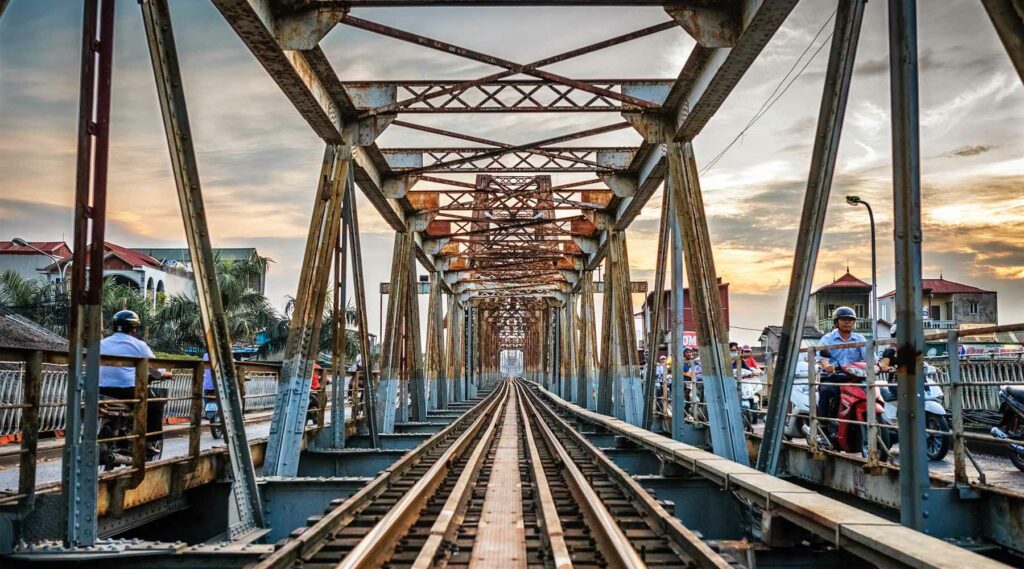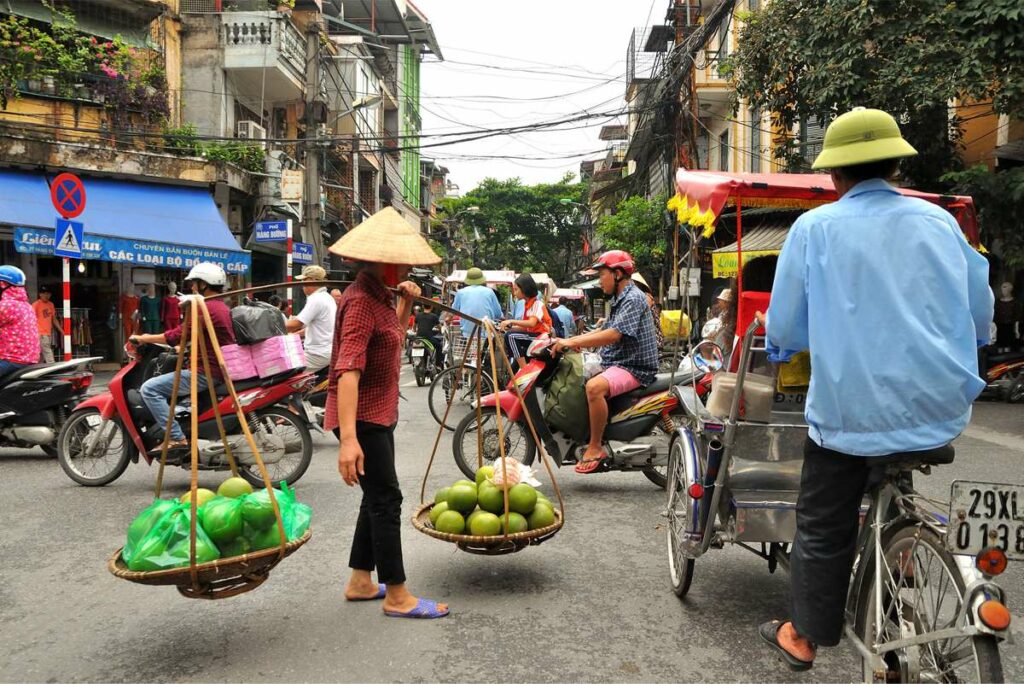What is Long Bien Bridge like?
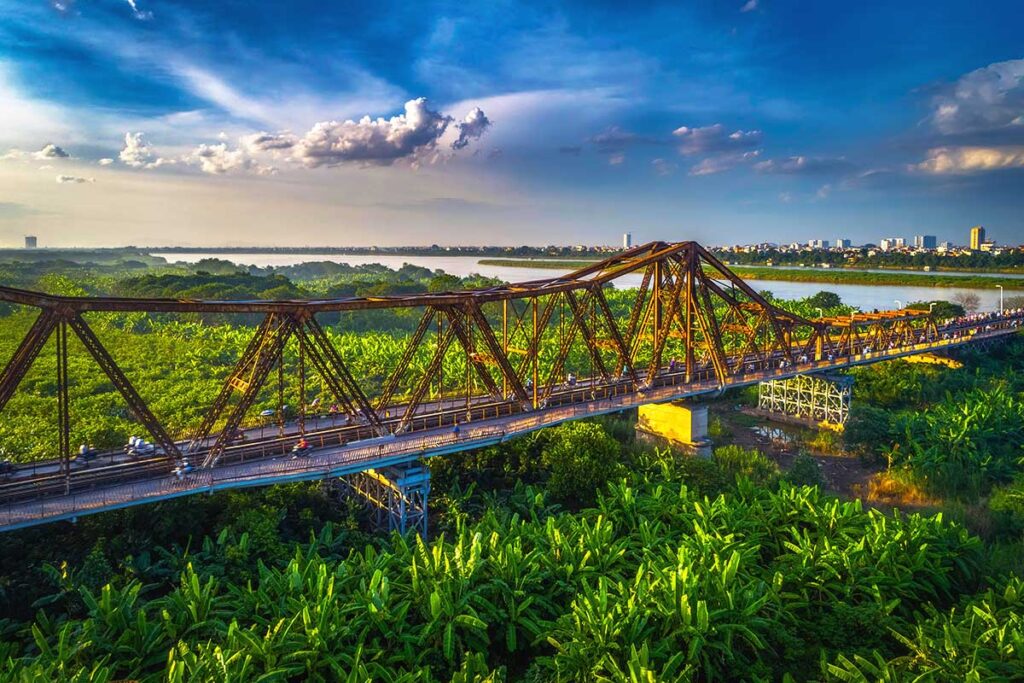
Long Bien Bridge is a massive steel structure stretching almost two kilometers across the Red River, built during French colonial times and scarred by heavy bombing during the Vietnam War. Today, its rusting beams, patched sections, and uneven pathways make it look worn, yet it remains very much alive — carrying trains, motorbikes, and pedestrians each day while cars take newer bridges elsewhere.
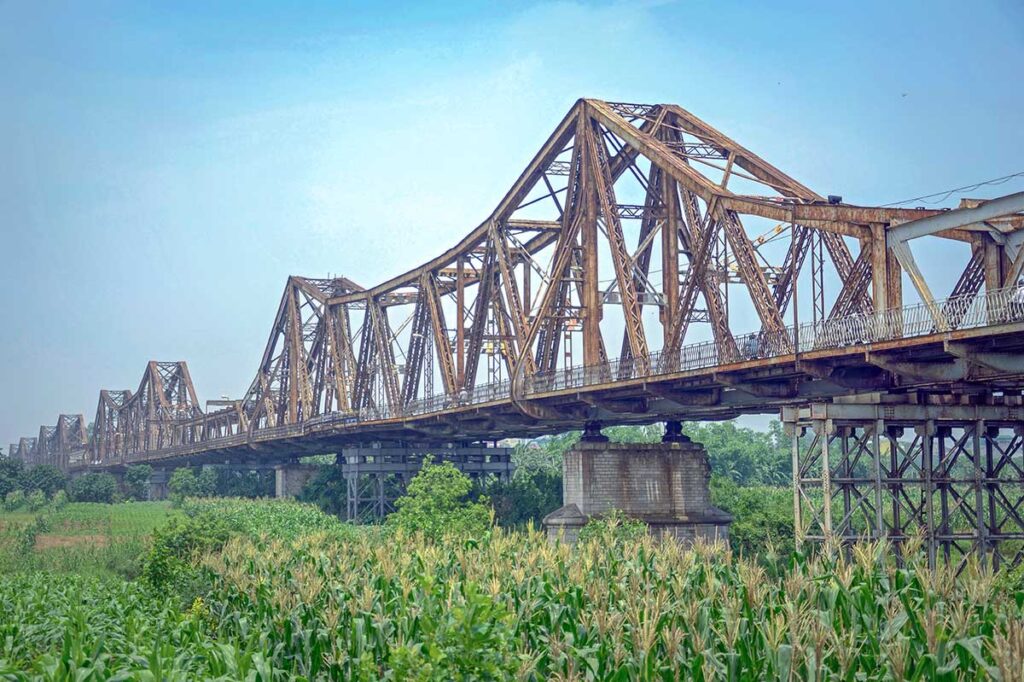
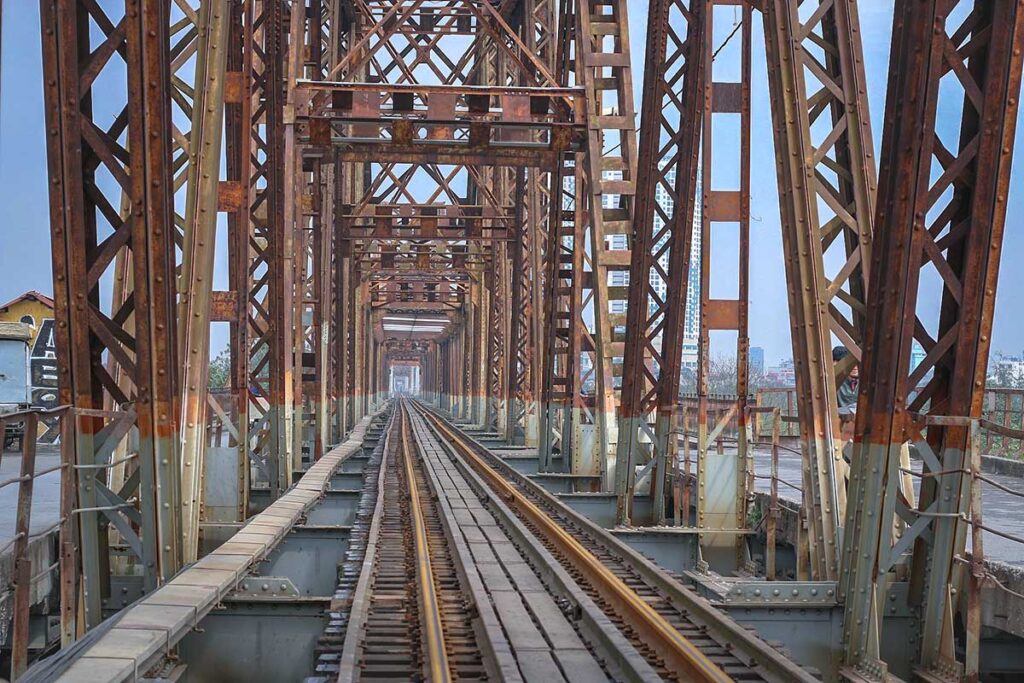
For travelers, it’s not a polished attraction but a rare blend of relic and working infrastructure, where you can sense history underfoot, catch panoramic views of the river, and see daily life unfold on the bridge and in the markets and gardens around it.
History of Long Bien Bridge
Construction under French Colonial Times
Long Bien Bridge was built between 1899 and 1902 by the French engineering company Daydé & Pillé — often mistakenly linked to Gustave Eiffel. At the time, it was one of the longest bridges in Asia, stretching nearly two kilometers across the Red River, and originally carried the name Paul Doumer Bridge after the then Governor-General of French Indochina. More than 3,000 Vietnamese workers were employed in its construction, which made it both a feat of engineering and a colonial showpiece.
Role during wars
The bridge became strategically important during Vietnam’s turbulent 20th century. In the fight against the French, it was a crucial link for supplies and movement between Hanoi and Hai Phong port, and during the Vietnam War it was bombed at least 14 times by American aircraft. Each time sections were destroyed, they were repaired, a cycle that turned the bridge into a symbol of resilience for Hanoians.
Modern times
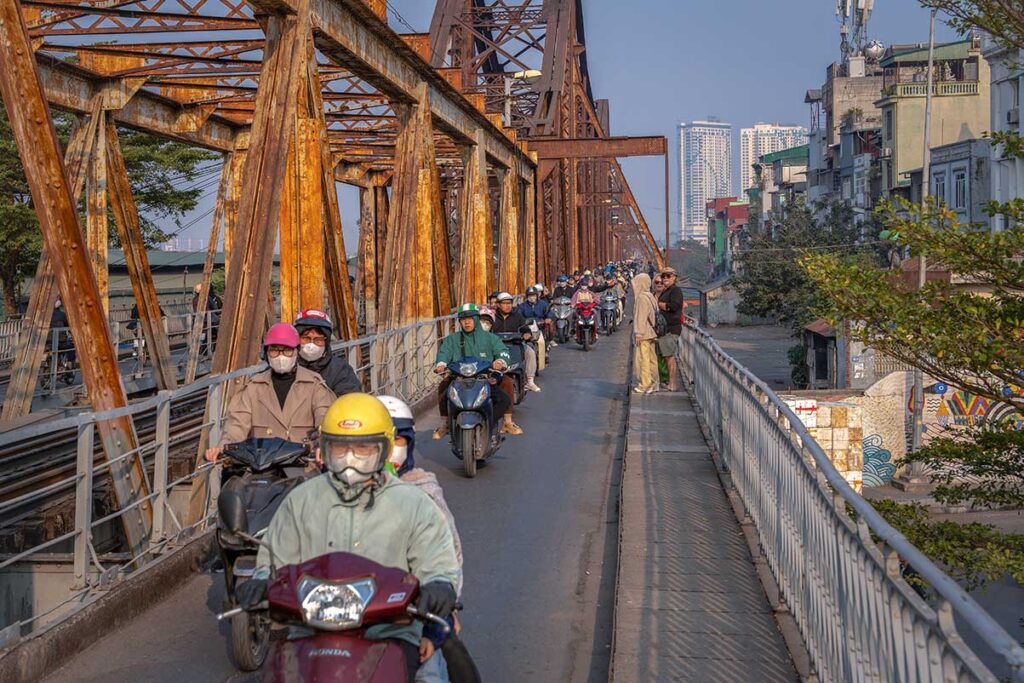
Today, Long Bien Bridge is a patchwork of original steel spans and repaired sections, half historic relic and half functional structure. It still carries trains, motorbikes, bicycles, and pedestrians, though cars are no longer allowed. Rust and wear are obvious, and walking across it can feel both atmospheric and slightly precarious. Plans for restoration, partly supported by French funding, are ongoing, but for now the bridge remains a living landmark — still essential to daily life while standing as a reminder of Hanoi’s past.
What to See & Do at Long Bien Bridge
1. Walk across the bridge
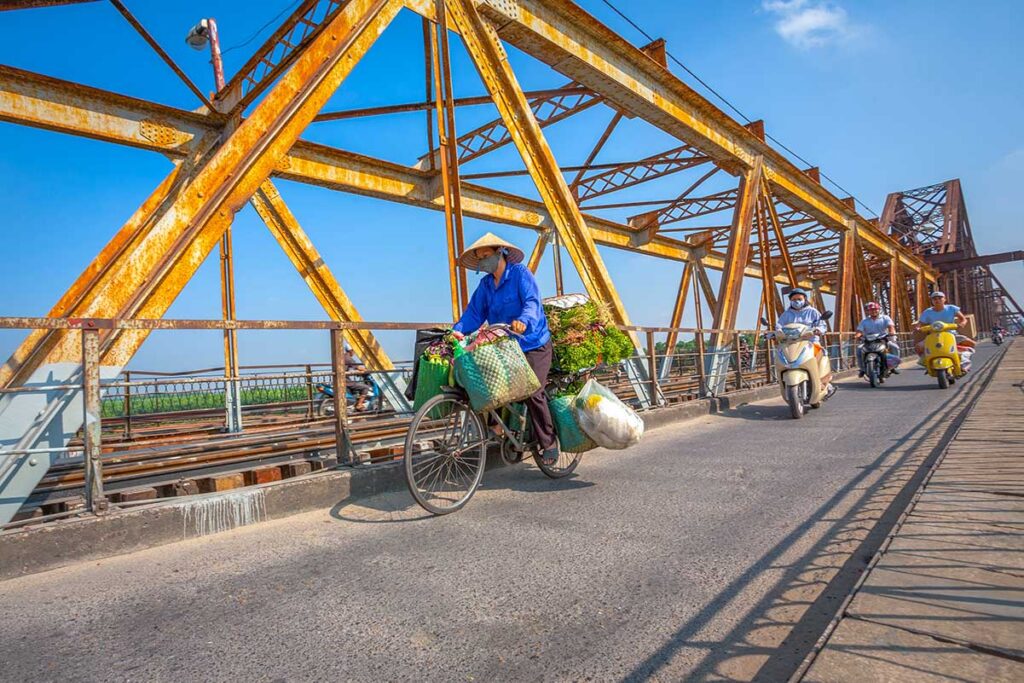
The simplest way to experience Long Bien Bridge is to walk across it. The pedestrian path runs alongside the train tracks, giving you a close-up look at the rusting beams and patched sections. It’s atmospheric but not exactly comfortable — the walkway is narrow, uneven in places, and the railing is rusty, so you’ll want to watch your step.
2. Watch the train cross
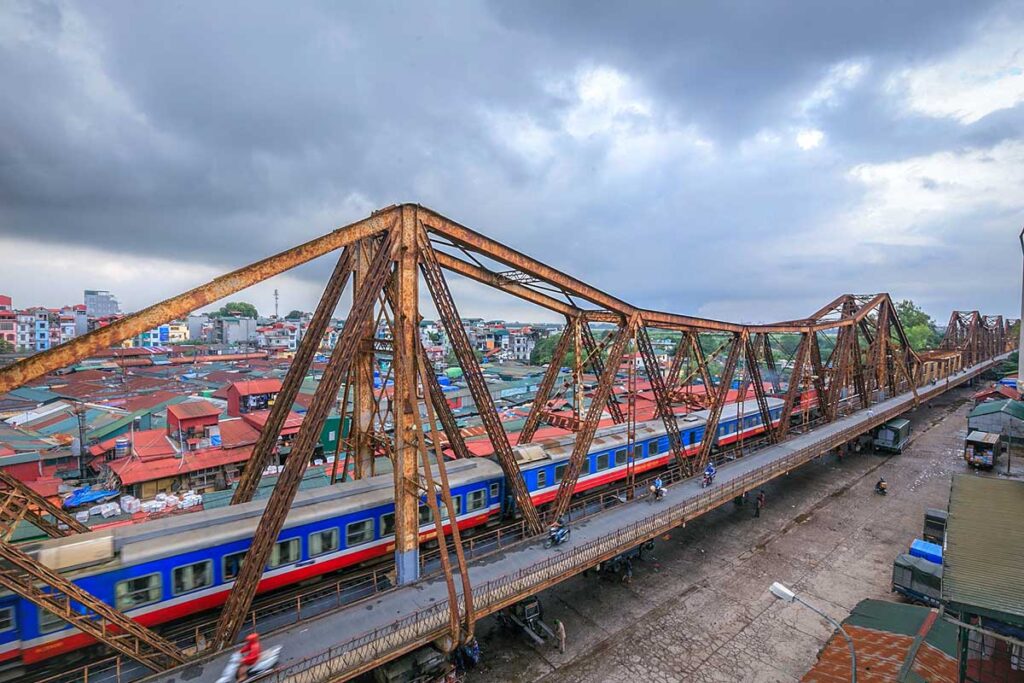
A highlight for many visitors is catching a train as it slowly rumbles across the bridge. Trains only pass a handful of times each day, but when they do, it feels like stepping back in time. The noise, the vibration, and the sight of the locomotive on this old structure add to the bridge’s historic character.
3. Sunrise & Sunset Views

Long Bien Bridge is one of Hanoi’s best spots for sunrise and sunset. In the early morning, the light glows over the Red River while the wholesale market below is in full swing. In the evening, the bridge becomes a favorite for photographers capturing the warm golden light reflecting on the water. Sunset is the more popular time, but sunrise offers a quieter, more local atmosphere.
4. Explore Banana Island below
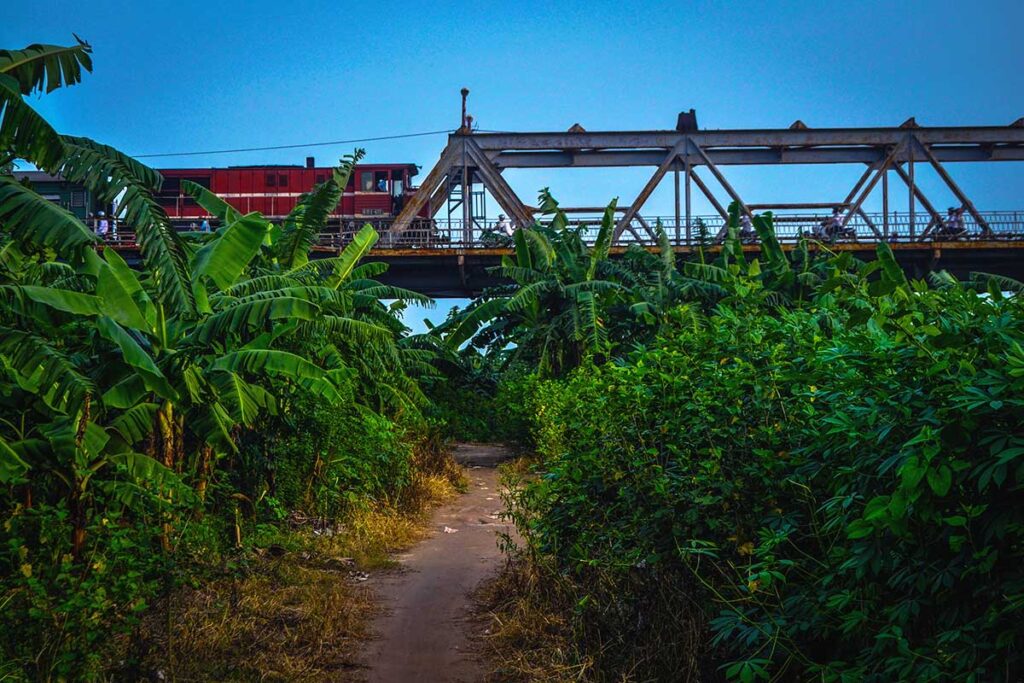
Beneath the bridge lies a strip of farmland known as Banana Island, where locals grow vegetables and fruit in the fertile river soil. It’s a very different perspective on Hanoi — green fields and small paths just minutes away from the busy Old Quarter. You can walk or cycle down here, and it’s also a hidden spot for unusual photos of the bridge rising above the fields.
5. Street snacks on the bridge
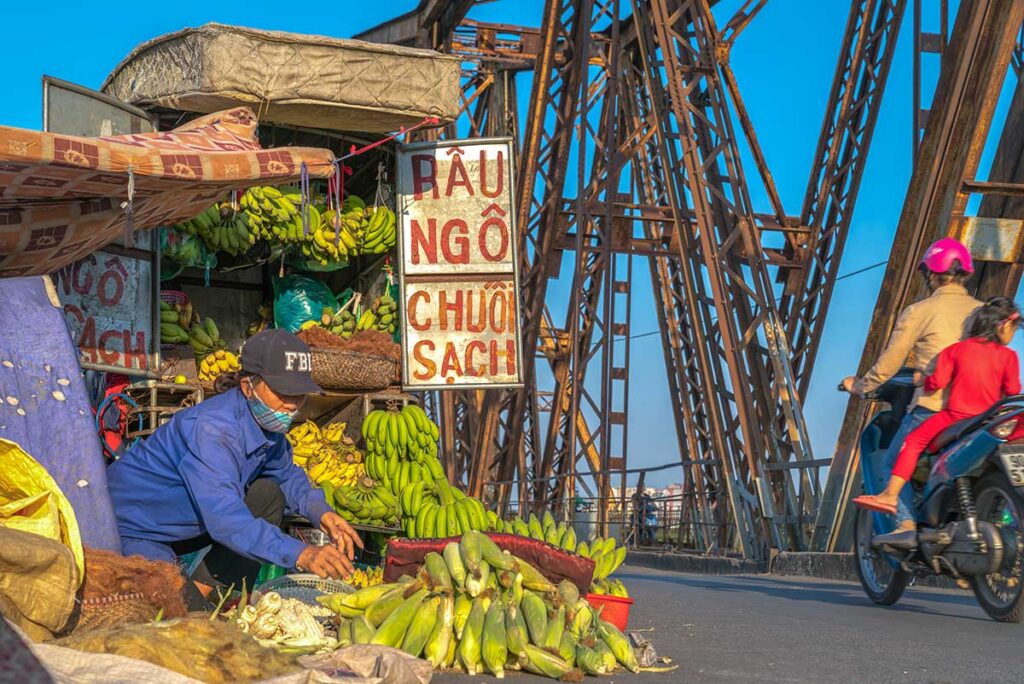
With so many motorbikes and bicycles crossing Long Bien Bridge each day, it has naturally become a spot where locals sell things to passersby. You might see vendors offering grilled corn or peanuts in the cooler months, or simply selling fruit and vegetables straight from their baskets. It’s not really about food tourism, but rather a glimpse into how the bridge is woven into daily life — not just as a crossing, but as a place where small trade happens right on the walkway.
Best viewpoints of Long Bien Bridge (Cafés)
Serein Café & Lounge
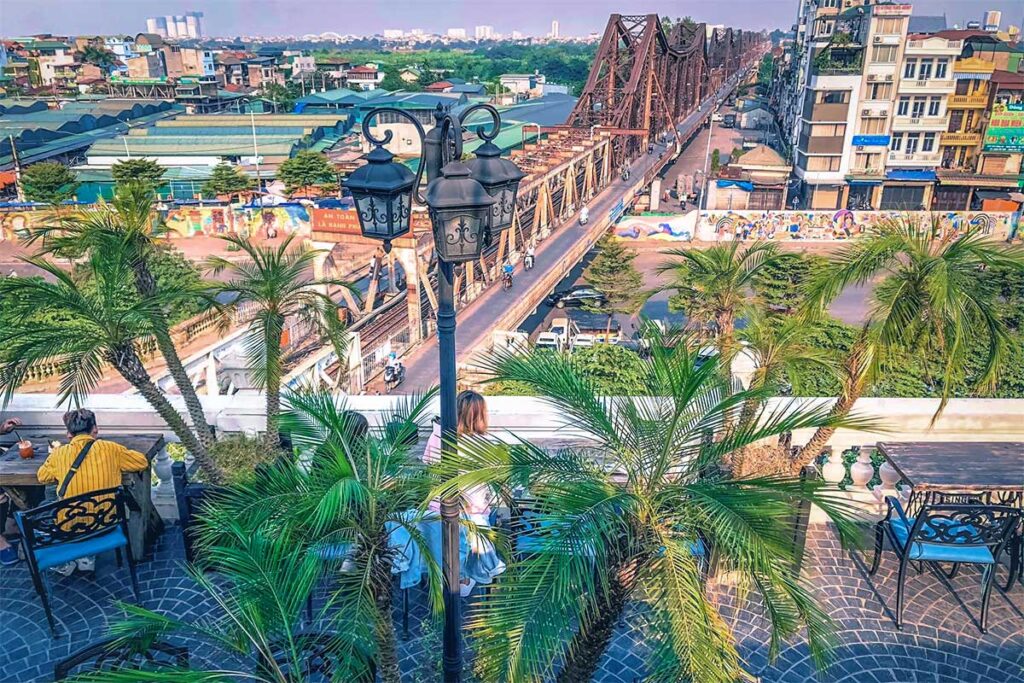
If you want the most dramatic view of Long Bien Bridge, Serein Café & Lounge is the classic spot. Tucked into an old building right by the train station, it doesn’t look like much from the outside, but head up the elevator to the upper floors and you’ll find a spiral staircase leading to a rooftop terrace.
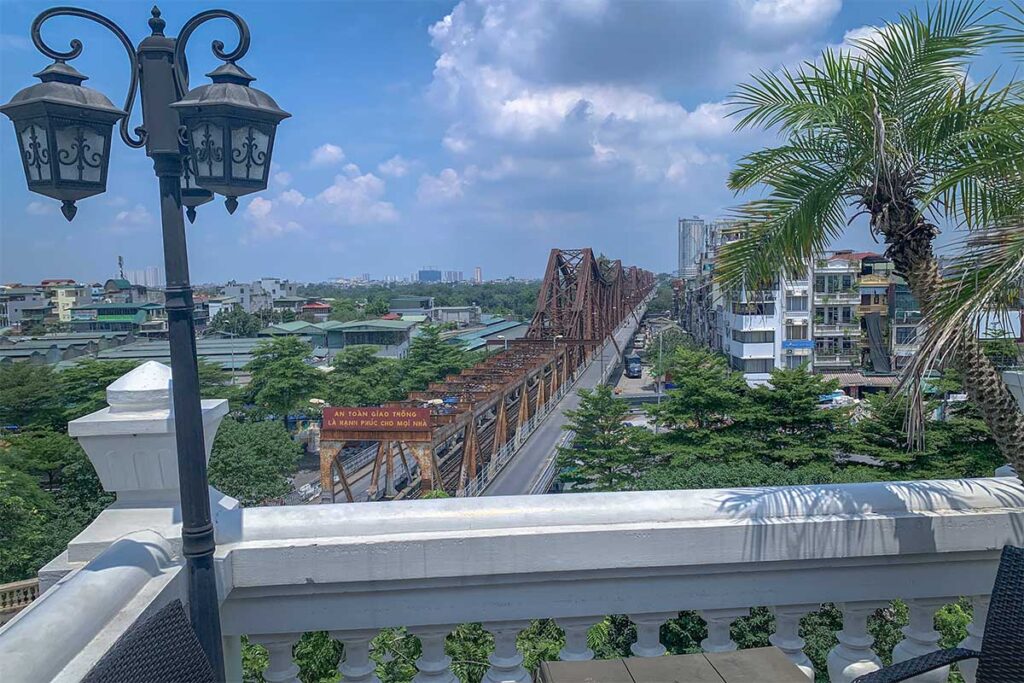
From here, the bridge stretches out across the Red River in full view, making it one of the best photography locations in Hanoi. The drinks themselves are nothing to get excited about and prices are higher than average, but most visitors come for the vantage point rather than the menu. Think of it as a “view café” — worth it for the scenery alone.
Bridge Coffee (Hidden Gem)
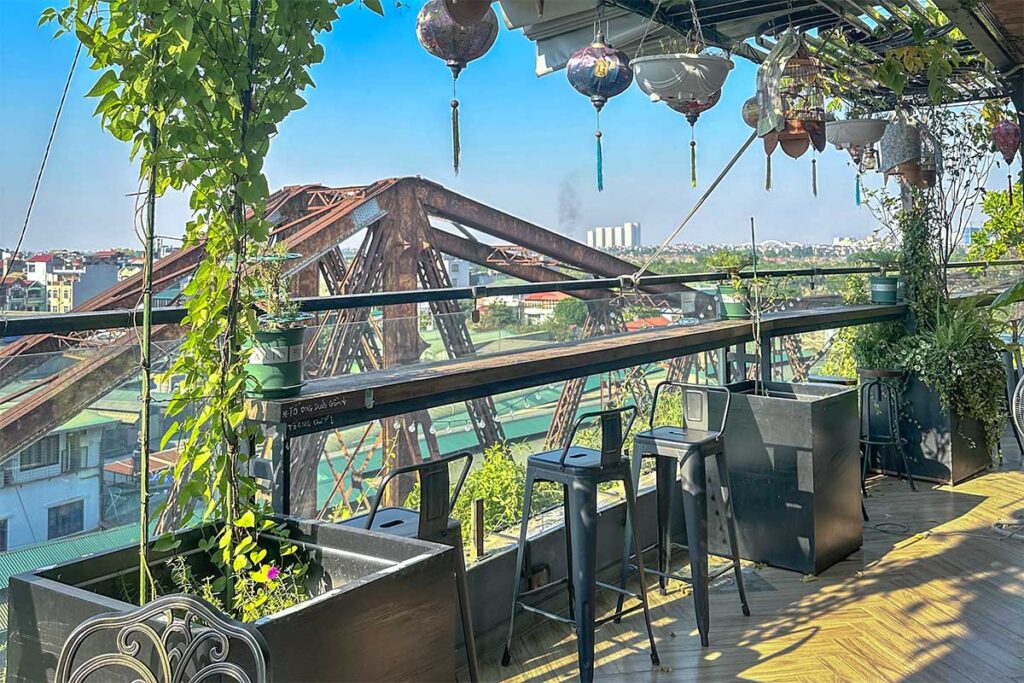
For a quieter and more down-to-earth option, Bridge Coffe is a great find. It’s a multi-level café right beside the bridge, with open-air seating on the top floors that give you a clear line of sight to the tracks and the Red River. You can even watch the train cross while sipping a strong egg coffee or a fruit tea.
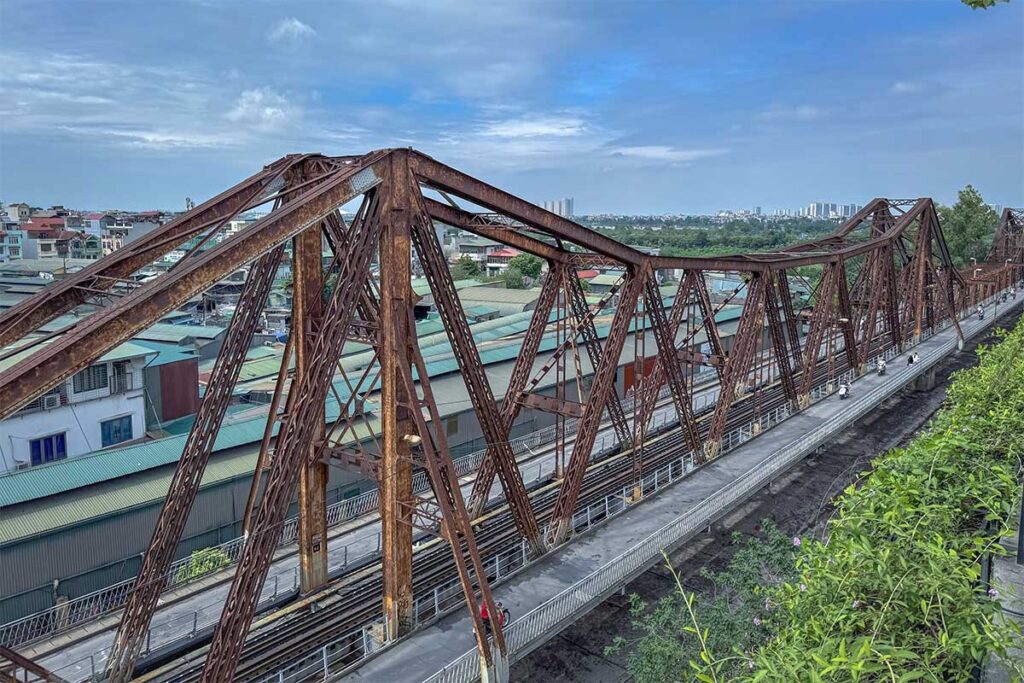
Compared to Serein, it feels more relaxed, less touristy, and easier on the wallet. It hasn’t hit the mainstream yet, which makes it a pleasant hidden gem for those who prefer something low-key but still want the view.
Other sights near Long Bien Bridge
Long Bien Market
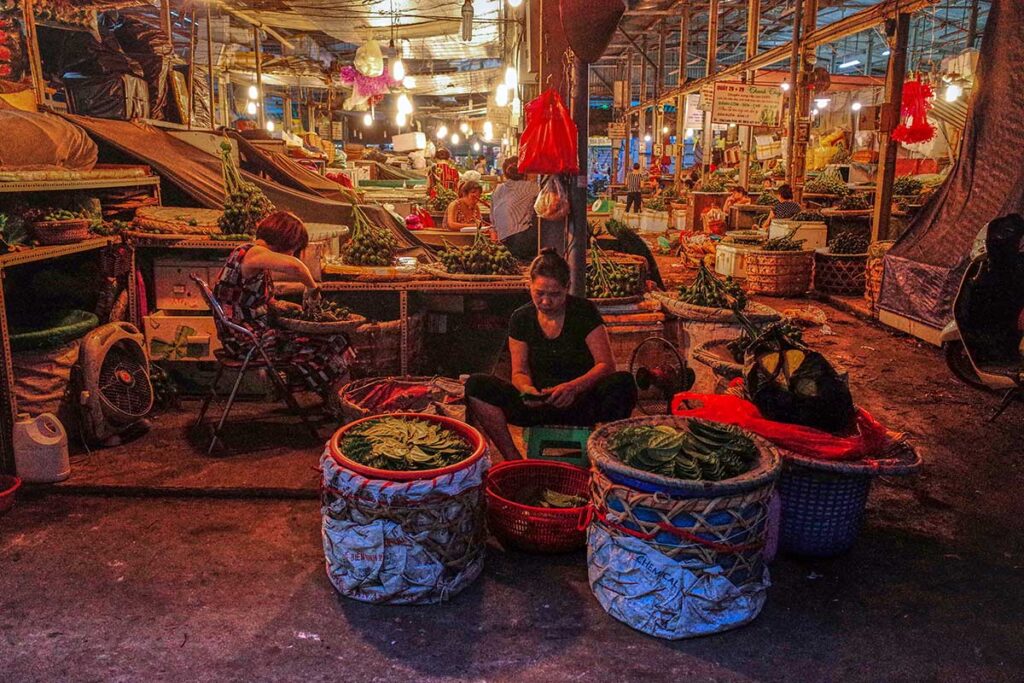
Right beneath the bridge you’ll find Long Bien Market, one of Hanoi’s busiest wholesale markets. It comes alive well before sunrise, with trucks unloading fruit, vegetables, meat, and fish from across northern Vietnam. The best time to visit is between 2 AM and 5 AM, when the chaos is at its peak. Be prepared: it’s crowded, noisy, and not particularly clean, but if you want to see the raw side of local life, this is one of the most authentic places in Hanoi. Combine it with an early morning walk on the bridge for a unique start to the day.
Long Bien Railway Station
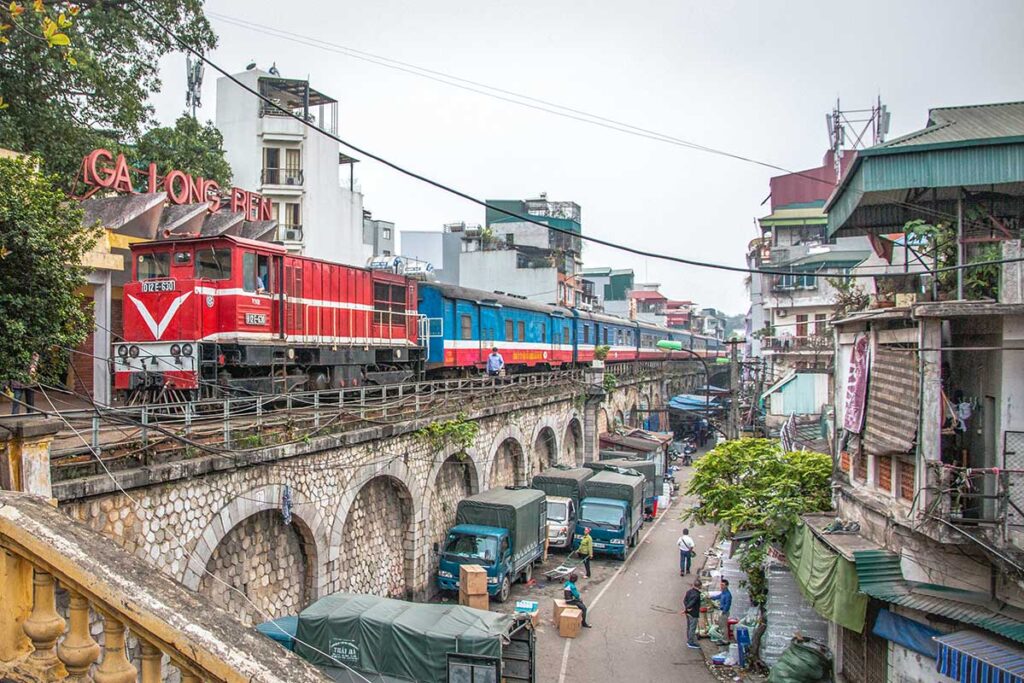
Just next to the bridge sits Long Bien Railway Station, one of Hanoi’s two main train stations. Unlike the famous “Train Street” that’s now heavily restricted, this is still a working station in a very local neighborhood, where you can watch trains pull in and out up close. It’s photogenic without the tourist crowds, making it a good alternative if you’re curious about Hanoi’s railway life but prefer something less staged.
Dong Xuan Market & Old Quarter
A short walk from the bridge brings you into the northern edge of Hanoi’s Old Quarter and to Dong Xuan Market, the city’s largest indoor market. Here you’ll find everything from fabrics and souvenirs to food stalls — not as intense as Long Bien Market, but still busy and very local. If you’re already visiting the bridge, it’s easy to combine with a wander through the Old Quarter’s narrow streets, street food spots, and historic architecture.
Practical Visitor Information
Best time to visit
The bridge is at its most atmospheric during sunrise and sunset. Early mornings are ideal if you want to combine your visit with the bustling Long Bien Market below, while evenings offer the best golden light over the Red River. Try to avoid rush hours (7–9 AM and 5–7 PM), when the narrow lanes are packed with motorbikes.
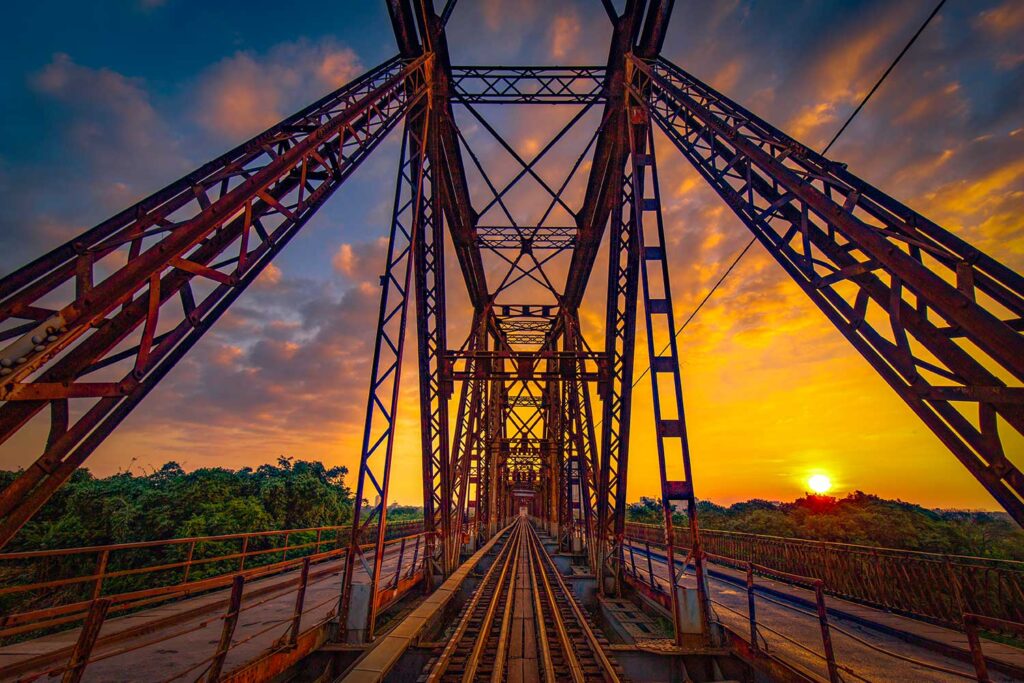
How to get there
Long Bien Bridge is only a 10–15 minute walk from Hanoi’s Old Quarter, making it very easy to reach on foot. If you’re coming from farther away, a quick taxi or Grab ride will drop you at either entrance. The bridge is also served by Long Bien Bus Station, where multiple city bus routes stop, though most travelers find walking or a short ride more convenient.
Safety & Tips
The walk across the bridge can be memorable, but it’s not the safest or most comfortable stroll. The pedestrian paths are narrow, with motorbikes passing close by, and the railings and concrete slabs are rusty or broken in places. It isn’t suitable for strollers or wheelchairs. If you go, wear sturdy shoes, stay alert, and bring your camera — the atmosphere and views make the effort worthwhile.
Tours option
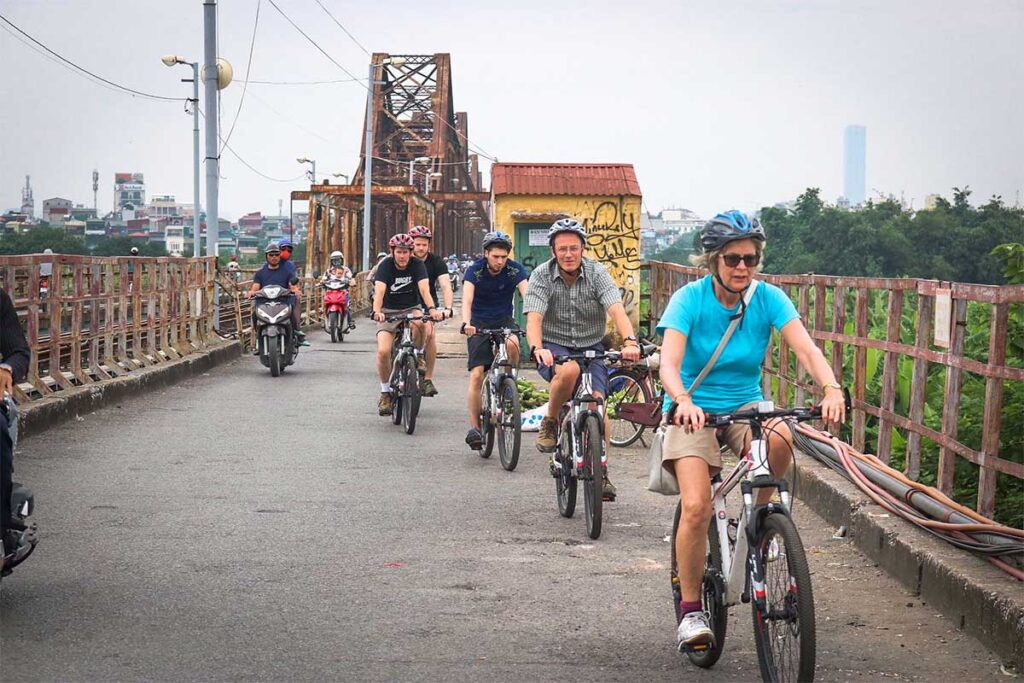
A great way to experience Long Bien Bridge is on our Hanoi cycling tour. It doesn’t just cross the bridge but also takes you into hidden areas along the Red River that most visitors miss. If you prefer, we can also arrange a private guide to include the bridge as part of a custom Hanoi itinerary.
